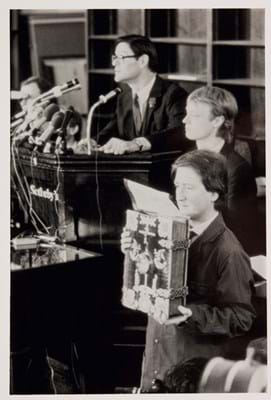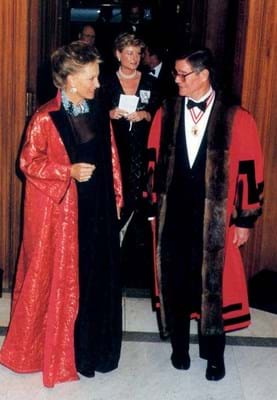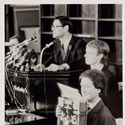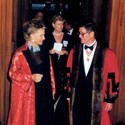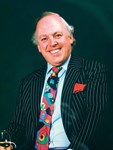After schooling in Africa before and during the Second World War, he attended Haileybury School, near Hertford, a popular choice for children of employees of the Colonial Office.
This was followed by National Service in the North Staffordshire Regiment, under the command of Colonel John Perreau*. Perreau was a very good amateur silversmith and enthusiast and thus visited Richard at Sotheby’s many years later.
Richard took a job at Sotheby’s in 1956, joining the silver department run at that time by Fred Rose** (1905-65) who in the early 1960s became ill with a heart condition.
Richard was suddenly pushed into a position of responsibility that was more than any young man starting out in their career could imagine. Fred’s assistant was Maureen Cox (Maureen Cotton, as she was when she joined Sotheby’s as a telephonist in 1935). She became assistant to Fred in the Second World War to help with cataloguing furniture and silver.
Under Maureen’s careful tutorage Richard soon established himself as ‘the silver department’, being active in the landmark sale of the Berkeley Castle Dinner Service on July 16, 1960. This world record-breaking sale, of a remarkable Louis XV silver service by Jacques Roettiers, Paris, 1735-38, gave him the taste for the limelight that became the norm for Sotheby’s (and Christie’s) as collecting silver became an established field of activity in the post-war era.
Father figure
I joined Sotheby’s some 10 years later on 26th September 1966. By 1967 when I was a trainee porter I became aware of Richard, who bowled up to me in the galleries one day, so full of life and cheer, and introduced himself at the same time as asking me who I was, where I was from etc… in a way that only Richard could!
Over the following 12 months he would greet me like the great friend and father figure that he remained, for the following 53 years. In early 1968 he offered me a position in the silver department and I snapped it up – who could resist working for a chap with such bonhomie?
Invariably when I got to the office at 8am I would be greeted by Richard in a white ‘lab-coat’ overall. He frequently got to work around 7am and started dictating catalogue entries to Maureen on the standard Sotheby office issue Remington Noiseless*** typewriter, each ‘property for sale’ requiring separate carbon copy sheets. There was a sale of 200-400 lots of silver every Thursday back then.
Richard became one of the most accomplished auctioneers at Sotheby’s and would often be on the rostrum for a myriad of sales. He took to the rostrum numerous times for the famous Mentmore House sale. He was fast and eagle eyed, taking bids with the uttermost charm and grace.
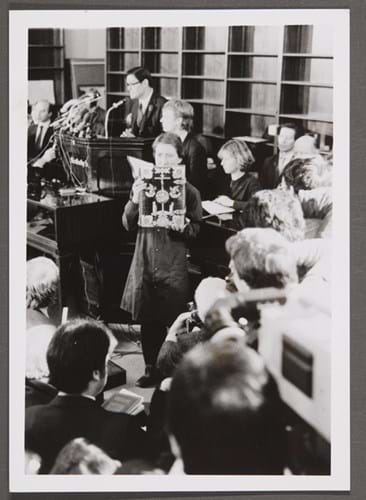
Richard Came auctioning the Gospels of Henry the Lion at Sotheby’s in 1983 which made a world record price at the time of £8.1m (photo courtesy of Sotheby's).
In 1968 Richard presided over the sale of the Elizabethan Westwell Livery Pots that are now part of the permanent collections of the Worshipful Company of Goldsmiths. They sold for £36,000 and the catalogue included a colour photograph of artistic design, much to the chagrin of parties interested in bidding for them.
In 1969 Richard and his family moved from Fulham to near Henley on Thames.
When living in London he would ride his ‘bone-shaker’ bike to the office at break-neck speed wearing pinstripe suit and bowler hat.
He became a bit of an icon in the West End and was occasionally photographed and interviewed for the glossies.
After moving to Oxfordshire Richard would commute from Shiplake and continued to jump on his bike at Paddington, which he chained to railings near the station overnight. This was a period when I got close-up knowledge as I rented the cottage that was part of the house he had bought. Ann and I were married from there and Richard stood in to give the father of the bride speech as Ann’s father was indisposed.
Instrumental role
Richard had become one of the dozen partners of Sotheby’s by 1964 having just turned 30, a position he held for another three decades.
He was instrumental with the other partners under the chairmanship of Peter Wilson in the rapid expansion of Sotheby’s into worldwide sales at auction, starting in the mid 1960s with sales in New York affiliated (1964) with Parke-Bernet Galleries Inc. These were followed by regular sales in Europe at Monte Carlo, Geneva and other venues, most of which included silver.
He was very much involved when Sotheby’s went public in the late 1970s and he was the first auctioneer to take a sale when the hated buyer’s premium was imposed.
Life in Bond Street included much cementing of friendships and careers. Lunches would be taken in various places such as the Time-Life building canteen and local restaurants and then, in the 1970s, the Sotheby’s boardroom in an elegantly decorated first-floor room overlooking St George’s Street – lunches prepared for the directors on most days or else important collectors and vendors would be wined and dined to hopefully cement their loyalty! Wherever there was activity in Sotheby’s, Richard could often be found presiding.
Fondly remembered
He became a Liveryman at the Worshipful Company of Goldsmiths in 1978 and in the mid 1980s Richard stood back from the silver department to take on managerial and guardianship roles.
He also devoted time to his appointment to the Goldsmiths’ Company Court of Assistants to which he was elected in 1988. He served as Prime Warden of the Company 2002-03.
Richard will be fondly remembered by a varied and wide number of people, all of whom he considered friends and companions – he will be sadly missed.
From Peter Waldron, author of the Price Guide to Antique Silver, 2nd Edition, Antique Collector’s Club, Woodbridge, 1982 and Sotheby’s employee 1966-2002, director and head of Sotheby’s silver departments following Richard Came
* A strange crossing of the paths of Richard and I happened in 1959. My father was just getting over my mother having left the family home, I was 11 and my brother David 13. Father decided to take us south from our Lake District home to show us London. We travelled in his newly acquired car (nicknamed the ‘tart-trap’), a bright red Singer Gazelle with go-faster side flash, to stay at the Cumberland Hotel, Marble Arch. It was then on to France and we drove to Lydd Airport where we boarded the car and ourselves on to a Silver City flight to Le Touquet. A night spent in Deauville and then on to Paris and Fontainebleau to stay with my uncle, Brigadier John Waldron, who was stationed there. House guests at the same time were Colonel John Perreau and his wife. My dad was a bit star-struck with Elizabeth Perreau!
** whose opening gambit to Victor Rothschild, 3rd Baron Rothschild on their first meeting, when asked where he was educated, was “Borstal and Wormwood Scrubs”…he was one of few grammar school boys employed by Sotheby’s at the time! Lord Rothschild was the one and same who loaned Mr Rose the money to buy his partnership in Sotheby’s.
*** The Remington Noiseless, which was built like a tank and sounded a bit like a machine gun when typing at speed. Maureen’s machine was inherited by John Culme who took it with him to Sotheby’s Belgravia when established in 1970. John went to the trouble of discovering that it had been made in 1946.

